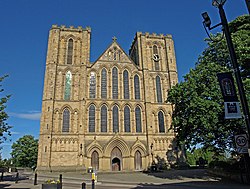Ripon Abbey
| City of Ripon | |
|---|---|
| City | |
 Ripon Cathedral |
|
 Arms of Ripon City Council |
|
| City of Ripon shown within North Yorkshire | |
| Population | 16,702 (2011 census) |
| OS grid reference | SE312714 |
| • London | 190 mi (310 km) SSE |
| Civil parish |
|
| District | |
| Shire county | |
| Region | |
| Country | England |
| Sovereign state | United Kingdom |
| Post town | RIPON |
| Postcode district | HG4 |
| Dialling code | 01765 |
| Police | North Yorkshire |
| Fire | North Yorkshire |
| Ambulance | Yorkshire |
| EU Parliament | Yorkshire and the Humber |
| UK Parliament | |
| Website | www.ripon.org |
Ripon (/ˈrɪpən/) is a cathedral city in the Borough of Harrogate, North Yorkshire, England. Historically part of the West Riding of Yorkshire, it is located at the confluence of two tributaries of the River Ure, the Laver and Skell. The city is noted for its main feature, Ripon Cathedral which is architecturally significant, as well as the Ripon Racecourse and other features such as its market. The city itself is just over 1,300 years old.
The city was originally known as Inhrypum and was founded by Saint Wilfrid during the time of the Anglian kingdom of Northumbria, a period during which it enjoyed prominence in terms of religious importance in Great Britain. It was for a period under Viking control, and later suffered under the Normans. After a brief period of building projects under the Plantagenets, the city emerged with a prominent wool and cloth industry. Ripon became well known for its production of spurs during the 16th and 17th centuries, but would later remain largely unaffected by the Industrial Revolution.
Ripon is the third smallest city in England. According to the 2011 United Kingdom Census it had a population of 16,702, an increase on the 2001 United Kingdom Census figure of 15,922. It is located 11 miles (18 km) south-west of Thirsk, 16 miles (26 km) south of Northallerton and 12 miles (19 km) north of Harrogate. As well as its racecourse and cathedral, Ripon is a tourist destination because of its close proximity to the UNESCO World Heritage Site which consists of the Studley Royal Park and Fountains Abbey.
...
Wikipedia

